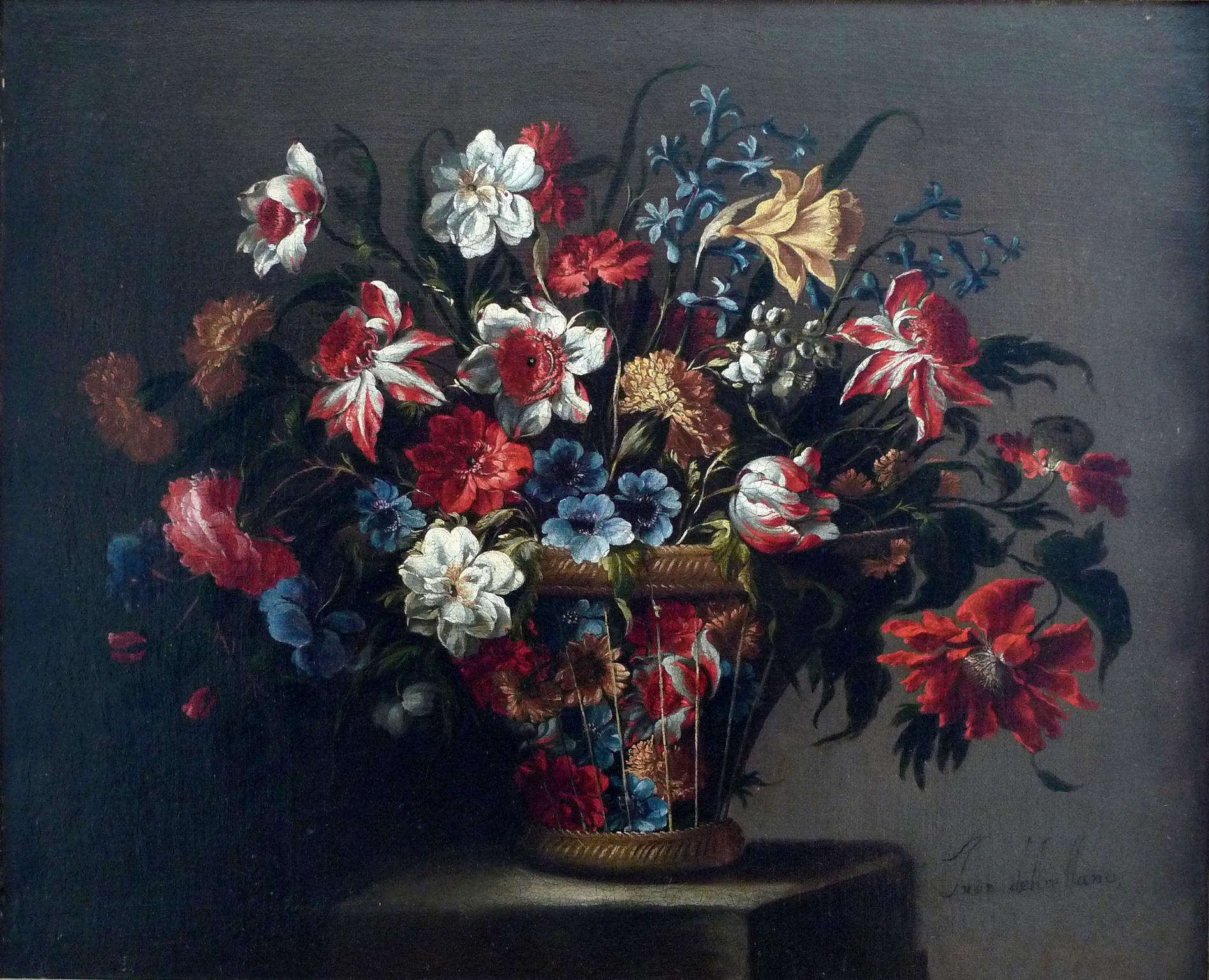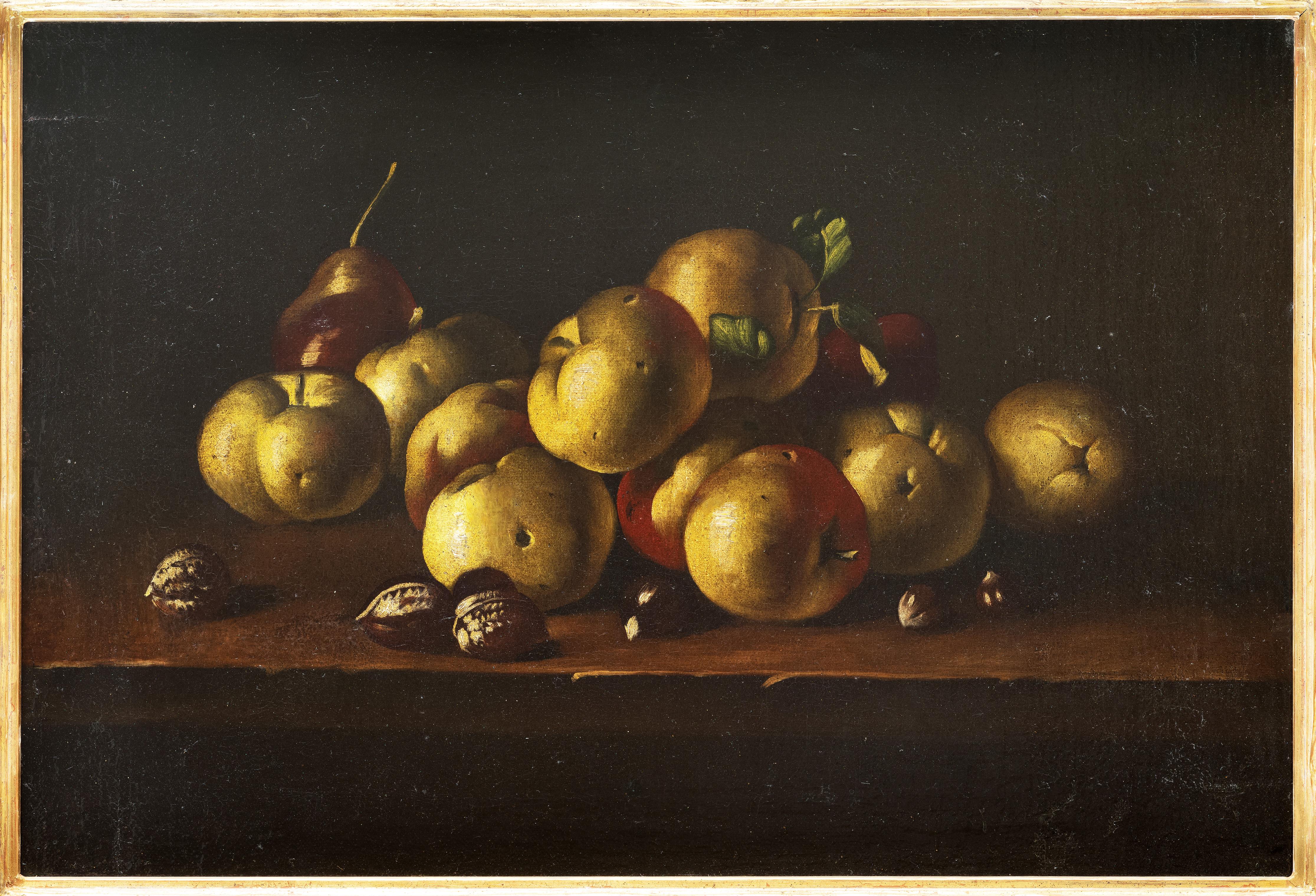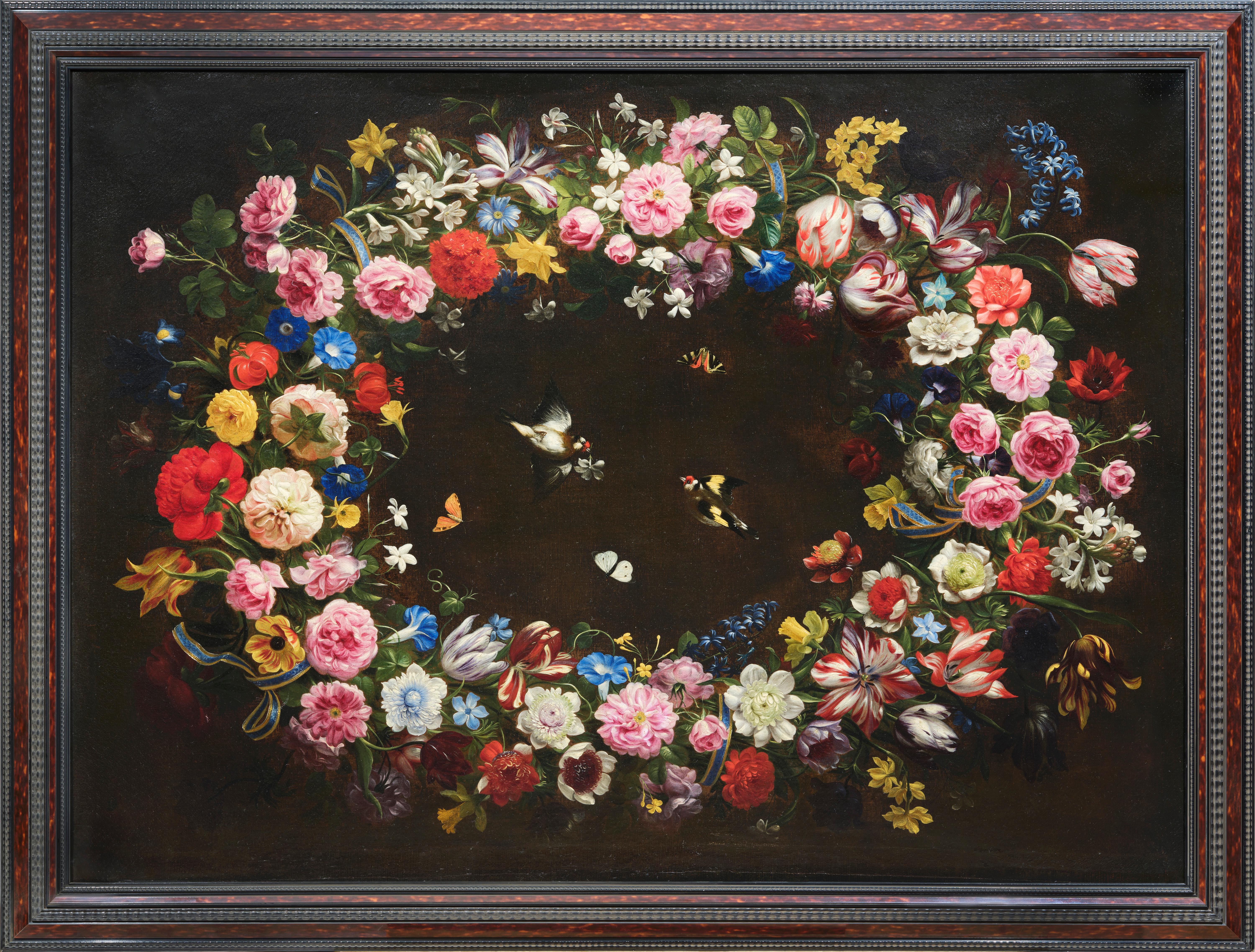Items Similar to RED GRAPES, RED WINE
Want more images or videos?
Request additional images or videos from the seller
1 of 5
Alexei KreydunRED GRAPES, RED WINE2003
2003
About the Item
RED GRAPES, RED WINE
Aleksei Kreydun studied the Old Masters and has revived their long lost techniques, building up multiple layers of oil paint and lacquer to achieve a depth and realism in his still lifes that create a visceral effect for the viewer.
Since 1995, the Pushkin Gallery has been representing exceptional works from the period of postwar Soviet Union up until 2014 when Russia invaded Crimea, at which time cultural exchange largely came to an end.
Kenneth Pushkin comments, "the paintings in this collection are rare and among the most significant examples of painting from this period - and they are beautiful. It’s notable that the highest-level works from this period have all but disappeared - acquired by museums or hidden in private collections."
In 2000, the Pushkin Gallery moved to a 300-year-old restored hacienda in the world-renowned art center of Santa Fe, New Mexico, where the unique gallery became a must-see destination for art lovers. With best-of-class curation and gallery practices, Pushkin Gallery became one of the most recognized purveyors of Russian art in the U.S.
Visitors commented that the Pushkin Gallery was like a museum. "Perhaps, it's because we disseminate knowledge," remarked Kenneth. "The difference between the Pushkin Gallery collection and a museum is that we offer collectors the opportunity to acquire gorgeous works of art that resonate with history at a very reasonable price.”
Since the inception of the Pushkin Gallery, over 30 years ago, many of the most important and beautiful paintings have been retained in a privately held collection and never shown publicly. Now for the first time, these reserved paintings are being selectively presented on 1stDibs.
- Creator:Alexei Kreydun (Ukrainian)
- Creation Year:2003
- Dimensions:Height: 15 in (38.1 cm)Width: 9 in (22.86 cm)Depth: 2 in (5.08 cm)
- More Editions & Sizes:original workPrice: $1,450
- Medium:
- Movement & Style:
- Period:
- Condition:
- Gallery Location:Santa Fe, NM
- Reference Number:1stDibs: LU2539212414382
About the Seller
No Reviews Yet
Vetted Seller
These experienced sellers undergo a comprehensive evaluation by our team of in-house experts.
Established in 1995
1stDibs seller since 2023
9 sales on 1stDibs
Typical response time: 1 hour
- ShippingRetrieving quote...Ships From: Albuquerque, NM
- Return PolicyA return for this item may be initiated within 3 days of delivery.
More From This SellerView All
- STILL LIFE WITH CATLocated in Santa Fe, NMVladimir Litveenov was born in 1956 in Tver Region of Western Russia. A graduate of the renowned Surikov Art Institute, he is the author of over 60 monumental, large format works painted in the vicinity of the famous artist retreat at Akademichiskaya Dacha. He is best known for his richly textured and highly detailed landscapes. This irresistible painting, Still Life with Cat...Category
1990s Impressionist Animal Paintings
MaterialsOil
- Summer on the RiverLocated in Santa Fe, NMSummer on the River Vasily Borisenkov was born in Mikhailov-Pogost, Pskov (near Leningrad) in 1924. Upon graduation from the renowned Repin Institute in St. Petersburg in 1954, he...Category
1980s Impressionist Landscape Paintings
MaterialsOil, Panel
- Road to the DachaLocated in Santa Fe, NMROAD TO THE DACHA (with Custom Seamless 24K Gold Frame) This beautiful landscape is an exemplary oil painting by the renowned master, Nikolai Timkov. It is in excellent condition and is framed in custom seamless 24K gold. Road to the Dacha, is being offered for an extraordinary price. Timkov paintings of similar size and quality have sold above $50K, with a record price of $350K in 2002. Nikolai Timkov At his 1993 exhibition, the year of his passing, Nikolai Timkov, one of the most important Russian landscape painters...Category
1960s Impressionist Landscape Paintings
MaterialsOil
- BACKSTAGELocated in Santa Fe, NMBACKSTAGE (with Custom Seamless 22K Gold Frame) Evgeny Balakshin was born in 1962 in Saransk, Russia. A member of the Professional Union of Artists of Russia, he received systematic art education in Saransk Art School under the direct tutelage of M. P. Shanin. Evgeny has worked and exhibited in France, England, Spain, Portugal and America. His works are included in the Mordovia Republican Museum of Fine Arts, the Collection of S.D. Erzya and other private collections. The paintings of Balakshin have a deep and philosophical presence, characteristic of the Russian school of painting...Category
Early 2000s Realist Figurative Paintings
MaterialsOil
- FOREST PATHLocated in Santa Fe, NMFOREST PATH Elena Gorbatsova, born in 1980, in the Tambov Region of Russia, was recognized for her extraordinary talent as a young child. At the age of 16, she was admitted to the ...Category
Early 2000s Realist Landscape Paintings
MaterialsOil
- MALCHIKLocated in Santa Fe, NMMALCHIK Evgeni Samsonov was born in 1926 in the city of Irkutsk, Siberia. Samsonov worked in the genre of “theme” painting and was a leading Social Realist, recognized for his superb painterly handling of anatomy. He made his artistic debut in 1951 and until his passing in 1988, participated in more than forty monumental art exhibitions in Russia and abroad. Evgeni Samsonov’s paintings can be seen at the museums of Russia. The artist’s works are included in private collections in Japan, France, Italy, England, Germany and Sweden. Since 1995, the Pushkin Gallery...Category
1950s Impressionist Portrait Paintings
MaterialsOil
You May Also Like
- Still Life with Fishes and Oysters - Oil on Canvas - 17th CenturyLocated in Roma, ITStill life with fishes and oysters is an original oil on canvas realized in the 17th Century by Neapolitan School Master. Impressive in size as well as for its vivid representation o...Category
17th Century Old Masters Still-life Paintings
MaterialsOil
- De Wit Flowers Still life Paint Oil on canvas 18th Century Flemish Cupids ArtLocated in Riva del Garda, ITJacob De Wit (Amsterdam, 1695 - 1754) attributable/ workshop Pair of Cupids with Garland of Flowers Oil on canvas 91 x 103 cm. - Framed 104 x 115 cm. Provenance: Christie's (London, Old master Painting 12.12.1996) lot 82 This magnificent composition depicts two cupids holding a garland of flowers, placed on a fine architecture with bas-reliefs and masks, presumably the top of a fountain. One of the two cupids sympathetically holds a part of it with his hands, while his head turns towards the viewer; the second cupid, on the other hand, must have clumsily broken the thread holding its end, and is sitting sullenly with a torch and a tear streaking his chubby cheek. The work, given its stylistic features and compositional taste, can be attributed to the Flemish artist Jacob de Wit (Amsterdam, 1695 - 1754), or to an artist from his workshop, with his typical triumphal and opulent style, which reveals clear influences from Rubens and Van Dijck, but also from Gerard de Lairesse...Category
18th Century Old Masters Paintings
MaterialsOil
- "Cesta de flores", 17th Century Oil on Canvas, Still Flowers by Juan de ArellanoBy Juan de ArellanoLocated in Madrid, ESJUAN DE ARELLANO Spanish, 1614 - 1676 Cesta de Flores signed Juan de Arellano (lower lright) oil on canvas original period carved, gilt and polychrome...Category
17th Century Old Masters Still-life Paintings
MaterialsCanvas, Oil
- A gentleman’s vicesLocated in London, GBEnglish School, circa 1827 A gentleman’s vices the newspaper dated ‘Sunday December 23 1827’ (upper left) oil on canvas 20 ¾ x 24 ½ in. (52.7 x 62.3 cm.) frame 25 ⅝ x 29 ¼ in. (65.1...Category
Early 19th Century Old Masters Still-life Paintings
MaterialsCanvas, Oil
- Still Life with Apples and Nuts, 17th Century, Old Master, Spanish PaintingLocated in Greven, DEJuan Sánchez Cotán (1560 - 1627) was one of the most important still life painters in Spain and beyond. He developed a certain type of still life with a ...Category
17th Century Old Masters Still-life Paintings
MaterialsCanvas, Oil
- Flower Garland by Giovanni Stanchi, the most Flemish Italian flower painterBy Giovanni StanchiLocated in PARIS, FRThis painting is reproduced in the reference book on Roman still life "Pittori di nature morta a Roma - artisti italiani 1630 -1750" by Gianluca and Ulisse Bocchi - Arti Grafiche Castello 2005 (page 250 figure FS5), where it is mentioned as one of the few paintings that can be given with certainty to Giovanni Stanchi. This highly decorative flower garland reveals a very strong Flemish influence, enabling us to attribute it with certainty to Giovanni Stanchi, the eldest of a sibling group of painters active in the production of still lifes in 17th century Rome. Probably painted before 1640, our garland conceals a mystical message beneath its decorative opulence, which we're about to reveal ... 1. Giovanni, Niccolò and Angelo Stanchi, a brotherhood of still-life painters in 17th-century Baroque Rome The three Stanchi brothers, Giovanni (1608 - after 1675), Niccolò (ca. 1623 - 1690) and Angelo (1626 - after 1675) lived and worked together (like the Le Nain brothers), making identification of the different hands perilous. Giovanni Stanchi's name is first mentioned in 1634, in the register of the painters' guild of the "Accademia di San Luca". Paid membership of the painters' guild provided not only a social network, but also commissions from important Roman families. In 1638, Giovanni Stanchi painted a picture for the Barberini family depicting their coat of arms surrounded by flowers. In 1660, he was commissioned by Cardinal Flavio Chigi to decorate a gallery with still lifes of flowers and fruit. The Chigis remained his principal patrons until after 1673. Thereafter, he received commissions from almost every important family in Rome. An invoice dated 1670 identifies Giovanni Stanchi and Mario Nuzzi as the painters responsible for the still lifes that decorated the famous mirrors in Palazzo Colonna. In 1675, Giovanni Stanchi's name appears for the last time in connection with a project in which he was engaged, together with Andries Bosman and the figure painter Ciro Ferri, to decorate the mirrors of the Palazzo Borghese on Campo Marzio. Although all three brothers were active as painters, the records of their commissions always refer to Giovanni, since, as eldest brother, he was responsible for invoices and contracts. Only in a few cases is the name of one of the younger brothers mentioned. Only paintings with a strong Flemish influence dating from the first four decades of the 17th century, such as this one, can be attributed with certainty to Giovanni, as he was the only painter in the family at the time. 2. History of a genre: the flower garland Jan Brueghel the Elder (Brussels 1568 - Antwerp 1625) is credited with inventing the flower garland theme during his stay in Rome in 1592. Such garlands were originally used to surround a religious subject, often a Marian one. This religious scene could sometimes be painted by another artist, as in the painting acquired in 1608 by Cardinal Borromeo, featuring a Madonna (painted by Henry van Balen), surrounded by a garland painted by Jan Brueghel. This theme was taken up and developed in Rome from 1625 onwards by Daniel Seghers, before the young Giovanni Stanchi made it his own, reinforcing its symbolic dimension (to which we shall return) and moving away from the naturalistic approach of Jan Brueghel to develop a certain idealization of each flower, closer to the style of Mario Nuzzi (Rome 1603 - 1673). Giovanni Stanchi's garlands, of which he was the best Italian interpreter in the 17th century, also reveal him to be one of the most faithful to the Flemish tradition. The book by Gianluca and Ulisse Bocchi lists nine still lifes very similar to ours, all executed on a black background (including the one reproduced as the last photo in the gallery, which belongs to the Pinacoteca Nazionale in Bologna). Because of their proximity to Flemish works, they can be attributed with certainty to Giovanni Stanchi. Four of them belong to private collections, while the others are all in public institutions (Anhaltische Gemäldegalerie, Dessau; Galeria del Palazzo Bianco, Genoa; Musée des Beaux-Arts, Bordeaux; Pinacoteca Nazionale, Bologna; Palazzo Chigi-Saraceni, Siena). Like those in Flemish still lifes, the flowers depicted by Giovanni Stanchi bloom at different times of the year, ruling out any representation of a real bouquet. Alongside the more traditional flowers of our gardens (roses, tulips, hyacinths, daffodils, irises), it is also interesting to note the frequent inclusion of more exotic flowers such as jasmine and blue bindweed (ipomoea indica), which had been recently introduced to Europe from Mexico. Each flower painted by Giovanni Stanchi seems to have its own individuality, a trait characteristic of Flemish painting, of which Stanchi was the best interpreter in Italy. One could say that Stanchi does not depict garlands of flowers, but flowers in a garland, each with its own identity and specificity, making it unique and different from the others. Captured in a low-angled light that seems to have captured them for eternity, they are drawn with clear, precise lines. As if they had been freshly cut, they emerge from the darkness in geometric figures that reinforce the tactile quality of their representation. One of Giovanni Stanchi's distinctive features is to have substituted the central religious representation traditionally associated with Flemish flower...Category
17th Century Old Masters Still-life Paintings
MaterialsCanvas, Oil
Recently Viewed
View AllMore Ways To Browse
Red Wine
Grape Art
Grapes Paint
Grapes Wine
Russian Old Masters
Grapes Oil
Oil Painting Grapes
Wine Still Life Painting
Still Life Painting With Wine
Still Life With Grapes
Grape Life Frames
Hacienda Mexico
Mexican Hacienda
Hacienda Painting
Tulip Still Life
Victorian Still Life
Still Life Painting Whimsical
Oil Painting Fruit And Flowers




